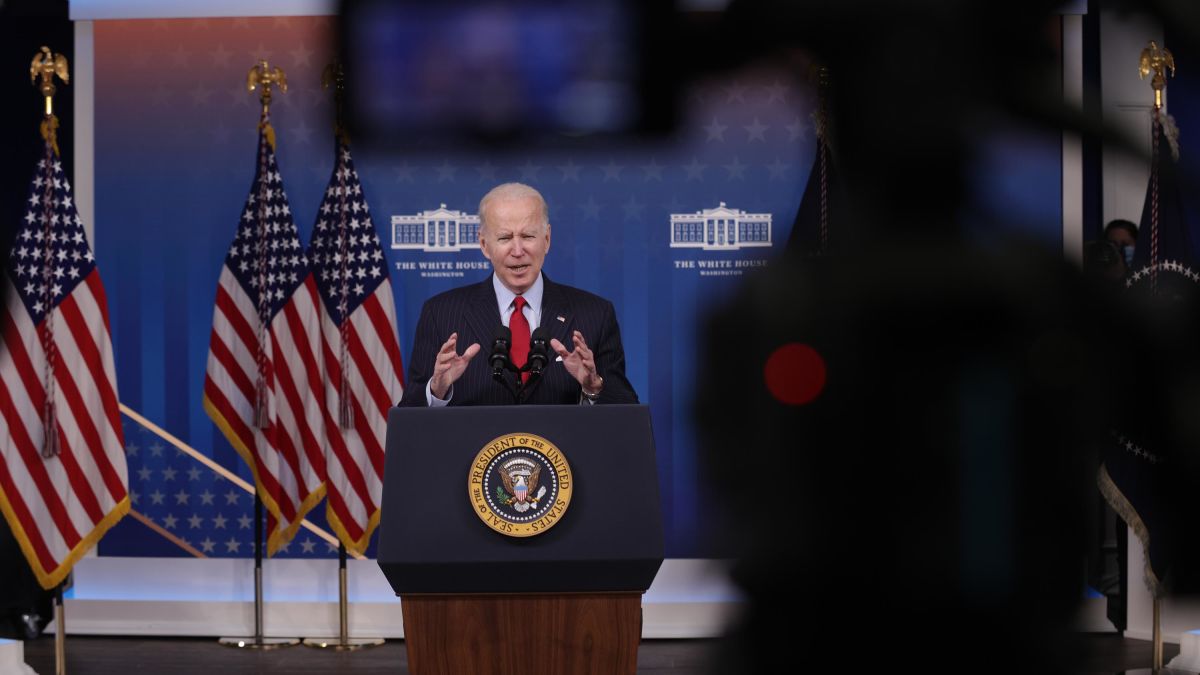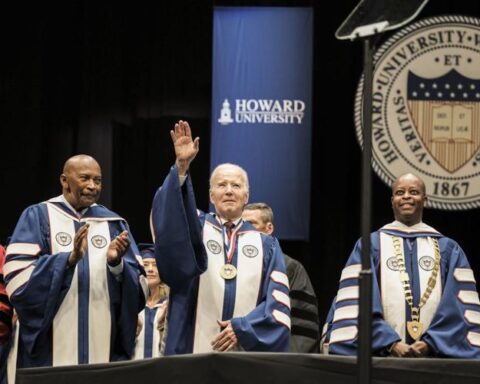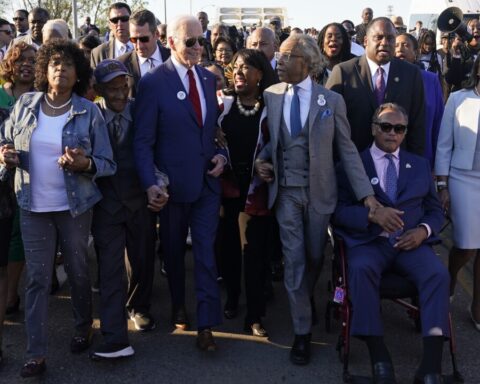When a president has to assure Americans there’ll be enough turkey for Thanksgiving, it’s a sure sign of national malaise.
That was the case Tuesday as the holiday season begins with citizens, already wearied by the worst public health crisis in 100 years, now punished by rising prices, the painfully high cost of gasoline and fears that winter’s arrival could mean another spike in Covid-19 cases.
President Joe Biden’s transformational agenda is designed to reorient the economy toward working people. But American wallets and morale are hurting now, so its complex programs, which may take months or years to deliver relief, won’t lighten the dark mood music on a holiday he is spending on Nantucket.
While there are some strong signs in the economy pointing to job and wage growth, Republicans are seizing upon the country’s difficulties to lambast Biden’s leadership, increasingly confident of big wins in the House and Senate next year. Every day brings new evidence for their case, with headlines about Dollar Tree raising its eponymous baseline price to $1.25 and with staples like breakfast cereal set to cost more in 2022.
As the reverberations of his coup attempt still threaten democracy, former President Donald Trump, meanwhile, appears to be accelerating a nascent reelection bid, using a series of interviews with genuflecting conservative media figures to portray his corrupt and lawless presidency as a prosperous golden age and claiming the nation is barreling into an economic abyss.
Many of the problems assailing Biden are beyond his control, including supply chain crunches and high global inflation brought on by the pandemic and elevated gas prices. But the political environment is getting so toxic that the White House felt obliged to underscore this week that the President fully plans on running for a second term in 2024. This treacherous backdrop explains Biden’s last major appearance before Thanksgiving, when he tried on Tuesday to convince Americans he intuits their pain, is listening and has plans that are already beginning to work. He painted a picture of a strengthening nation, overcoming Covid-19 and its economic reverberations and getting back to work as travelers throng airports for the first full-scale holiday gathering in nearly two years.
“We’ve made historic progress over the last 10 months,” Biden said, noting a much reduced 4.6% unemployment rate. “There’s a lot we can be proud of and a lot we can build on for the future.”
Ironically, Biden addressed current economic challenges after one of the most successful periods of his presidency. He just signed into law a bipartisan infrastructure package that passes for a legislative miracle in today’s polarized and gridlocked Washington. His companion $1.9 trillion social spending bill finally cleared the House last week, though its fate in the Senate is uncertain given the Democrats’ minuscule majority.
Even some Biden voters think Democrats don’t get it
One of the lessons some Democrats took from their shocking defeat in the Virginia gubernatorial election earlier this month — which saw a 12-point swing in just a year to the Republicans — was that they had stopped listening to voters. After the GOP triumph, the center-left think tank Third Way conducted focus groups among Biden voters to find out why they had backed Republican Glenn Youngkin this year. The findings were chilling for Democrats, revealing that these voters could not name anything Democrats had done, were unhappy with the direction of the country — including labor shortages and high prices — and didn’t think the party gets it. The groups also believed the economy is bad, despite some encouraging statistics, and think Democrats care more about social issues than the factors currently making it hard for families to make ends meet.
In recent days, Biden has appeared to have initiated a rhetorical reset, perhaps to address such liabilities, after earlier this year insisting that inflation was transitory, that his influence was limited in bringing down high gas prices and that the pandemic was virtually over in a premature July Fourth speech.
“Moms and dads are worried, asking, ‘Will there be enough food we can afford to buy for the holidays? Will we be able to get Christmas presents to the kids on time? And if so, will they cost me an arm and a leg?'” Biden said Tuesday.
Seeking to project control and instill confidence, he announced the largest-ever release of oil from the Strategic Petroleum Reserve in a bid to ultimately increase supply and drive down pump prices. The President went out of his way to counter another GOP attack line — that his effort to tackle climate change was to blame for higher gasoline costs. And he explained how his White House had reduced the back-up of containers in ports and leaned on top executives of major retailers like Walmart and Target to move supplies faster. Such moves could not only ensure store shelves remain stocked but could also temper the raging demand that is driving inflation.
“Families can rest easy. Grocery stores are well-stocked with turkey and everything else you need for Thanksgiving. And the major retailers I mentioned have confirmed that their shelves will be well-stocked in stores this holiday season,” Biden said. “That’s good news for the those moms and dads worried about whether the Christmas gifts will be available. It goes for everything from bicycles to ice skates,” he added, pushing back against a GOP narrative that Americans face the most deprived and expensive holiday season in history.
While Biden’s moves might be politically effective at the margins, there are real questions about their potency in the long-term and therefore about their capacity to reverse the slump in his approval ratings into the low 40s, and below, in some polls.
Much is out of Biden’s control
The biggest challenge for the White House is that while Biden can show he cares about current national problems, he may not be able to quickly alleviate them.
While Republicans charge that inflation is being driven by high Democratic spending, the fact that this is a worldwide scourge means it’s hard for him to fix it. The supply chain crisis that is hiking prices is caused by Covid-19’s ravaging of the manufacturing base in Asia — something beyond Biden’s control. While his release of 50 million barrels of oil is historic and will be accompanied by similar spigot openings by US allies, it may only have a limited effect. Americans generally use around 20 million barrels a day. And Organization of Petroleum Exporting Countries still have a stranglehold on global supply and prices.
The big and perhaps only hope for the White House and Democrats running in 2022 is that the political situation will ease. An end to the pandemic, more job growth and repaired supply chains could improve the nation’s mood considerably and boost the President’s approval ratings, which are critical to the party’s midterm hopes. By then, the administration hopes that the first effects of the infrastructure law and social spending bill, if it passes, will begin to be felt, giving them a strong platform of renewal and reform.
Still, the party must also hope that the damage to Biden’s image as a straight-shooter and reputation of competency, suffered during a brutal political period that included the chaotic withdrawal from Afghanistan, will not linger.
As years of turbulence have shown, no one — least of all Republicans already taking a premature victory lap — should make any assumptions about future elections. But this Thanksgiving, the country is yet to emerge from the crisis that Biden was elected to end — the pandemic — and is confronting new and knock-on political and economic challenges.
So while announcing that Biden plans to run for reelection is an easy play for the White House now, the President’s long-term political future rests on the same proposition it always has — his ability to restore some kind of economic and political normality. That destination remains elusive and, for multiple reasons, may be getting even harder for him to drag the nation toward.





